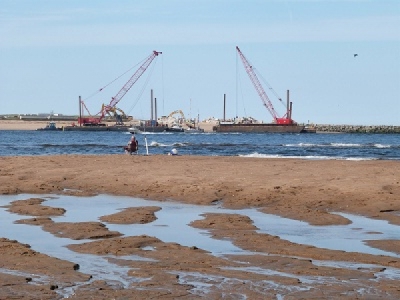
Posted on October 22, 2017
By Jack Shea, Daily News
The Merrimack River Beach Alliance is moving along with plans to dredge sand from the Merrimack and Piscataqua Rivers and spread it on local beaches to protect houses threatened by beach erosion.
At a meeting Friday morning, the MRBA discussed the soon-to-begin permitting process for the project, which aims to dredge 600,000 cubic yards of sand from the two rivers and use it to build up beaches affected by erosion in Salisbury and Newbury.
The MRBA, which is comprised of local and state leaders, along with members of the U.S. Army Corps of Engineers, discussed options for where the sand could be dumped. The project’s base plan includes two disposal sites off either Plum Island or Salisbury Beach, which comes at a $3.5 million cost that would be covered by federal funds.
Another option would be to dump the sand directly onto the north end of Plum Island. This would come at an estimated cost of $5.5 million, with a sponsor being required to provide the extra $2 million on top of the federal funds. Planting beach grass or putting up fencing would be additional costs.
Bob Boeri, project review and dredging coordinator at the Massachusetts Office of Coastal Zone Management, said that an environmental notification form must soon be filed under the Massachusetts Environmental Policy Act, which would lay out the purpose of the project and outline where the sand will go and address its potential environmental impacts. Boeri said that once the MEPA process is complete, the MRBA may start undergoing the federal permitting process.
And while the project’s timeline depends on where MRBA members decide to dump the dredged sand, Boeri said that the permitting process should move “relatively quickly” once the appropriate information is put in place.
MRBA members hope the project will provide a long-term solution to the area’s erosion problem that has resulted in high tides encroaching upon nearby houses.
Ed O’Donnell, member of the Army Corps of Engineers, emphasized the importance of choosing a final destination for the dredged sand, and said the group must meet with resource agencies to gain the necessary approvals for the project.
“We need to make a decision on where the material will go. Left to our own devices, we would place it at one or both of the near shore sites which we have identified,” said O’Donnell.
When asked how long the sand would last O’Donnell said the results are somewhat unpredictable, and will depend on future environmental behavior.
“If you put the material into the beach system, it’s available for nourishment,” said O’Donnell. “The material will trip the waves and lessen their impact on the beach. We had done some back in the 1970s, and it lasted for a few years, but it’s hard to say how long this sand will last without knowing what storms will be coming in and what will impact it.”
Source: Daily News





